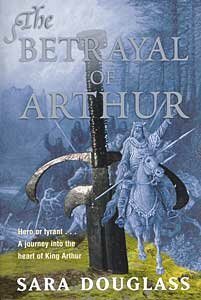|
The Betrayal of Arthur - Sara Douglass
Pan Macmillan, September 1999, tpb, 325pp, $24.95.
Reviewed by Sophie Masson

The Arthurian legend, and the cycle of medieval romances which tell its story, reinvigorated medieval culture and paved the way for the modern novel: not just the fantasy novel, but also the novel of psychology. For the legend is a quite extraordinary blend-neither quite myth nor quite history, quite Christian or quite pagan, a complex blend of the mundane and the Otherwordly, a sychological exploration and a great adventure, it is a vast tree, with its roots in Celtic myth, its trunk in the Middle Ages and its branches and offshoots and suckers in our own times. Its continued freshness and relevance to our own times is undoubted; it is the fantasy template par excellence, and its symbols and motifs have permeated all of Western culture in the deepest possible way.
Even in resolutely secular, 'dun-coloured-realist' Australia, the Arthurian motif has appeared, in both fantasy and mainstream novels. Now Australia's top fantasy author tackles the Once and Future King on his own turf-the turf of the borderlands between myth and history. This non-fiction exploration of the doomed and dooming Arthur, those closest to him and the images of him, reveals Sara Douglass' deep knowledge of the area, and her historian's understanding of the Middle Ages in particular. She does not gush about Arthur-indeed, in many ways it could be said that her King has very heavy feet of clay indeed. But she is true to the complexity and the shifting nature of the legend, and the ways in which it has been interpreted and re-interpreted over the centuries.
Douglass covers many of the key medieval texts, such as Geoffrey de Monmouth's History, Chretien de Troyes' works, Malory's famous Morte d'Artur, and many others. She does not assume prior knowledge on the part of the reader, and retells the major parts of the legend. She also profiles a couple of post-medieval texts, as well as modern writers such as T.H. White, Rosemary Sutcliffe and Marion Zimmer Bradley. She looks at the ways in which the legend has been used since the earliest times-its political and social and religious uses, and its psychological explorations. She does not, however, cover the magical, mysterious Celtic-derived concept of the Otherworld and its role in Arthur's life and legend, a concept which to my mind was the main reason for its early and phenonemal popularity. But she does profile Morgan, Morgause and Nimue in the way that they were portrayed by the later medieval writers, as wicked or at least dangerous enchantresses, and in that way damning all female humanity-especially when you combine that witchy trifecta with false, shallow Guinevere! It is certainly the view reacted against by such writers as Zimmer Bradley and other feminist authors, seeking to reclaim the legend for women. In any case, that feminine stream, while less mainstream than the views of Chretien and Malory, the two most influential Arthurian writers, has been there all along, in the works of writers such as Marie de France or Hedris of Cornwall, for instance. And in those works the Otherworld is not threatening but wondrous and extraordinary: it is the world of subtle reality, the world within the world. Early on, the people of Camelot have a relationship with that Otherworld which is seamless and true. Only when they have lost faith in it do the problems begin. Then women, often seen as emissaries of the Otherworld, are demonised; and the quest for the Grail begins: the Grail which symbolises that lost oneness.
Douglass certainly casts many forthright glances at the misogyny of the treatment of many of the female characters-poor Guinevere, the empty vessel; wicked Morgause and dangerous Morgana and duplicitous Nimue. She also profiles Mordred, arch-villain, and Lancelot, parfait knight and devoted lover. And Arthur, of course: King, and orphan; lover and warrior, complex, betrayed betrayer. Douglass' analysis of character is interesting and thought-provoking, and remind us very much that Arthurian romances were not only magical journeys, but also some of the first ever psychological 'novels' (in fact in French, a novel is still called 'un roman': the novel certainly does not date from the 18th century).
As well, Douglass thoroughly examines the attempts to place Arthur in history, and the quasi-spiritual cult surrounding him, both in medieval times and now, and concludes that though Arthur should not be portrayed as saviour, it is indeed the legend, and not some never-to-be-proven historical 'real man', that is of deepest importance to the culture: a conclusion with which I absolutely agree.
- Readers note: a 'romance' in medieval terms was a narrative written in one of the Romance languages-ie those influenced by Latin, rather than in Latin itself. These romances were popular literature written in the common tongue, and the true ancestor of modern fantasy.
Sophie Masson's latest novel, The Lady of the Flowers, Book Two of the Lay Lines trilogy (published by Bantam Books) is based on Arthurian motifs, including Marie de France's Lay of Sir Lanval, and Welsh material. She is also one of the organisers of Grail Quest 99, the first Arthurian festival to be held in Australia, and a foundation member of the Arthurian Association of Australia.
©2000 Sophie Masson.
Published online: 10 March 2000. |

|

